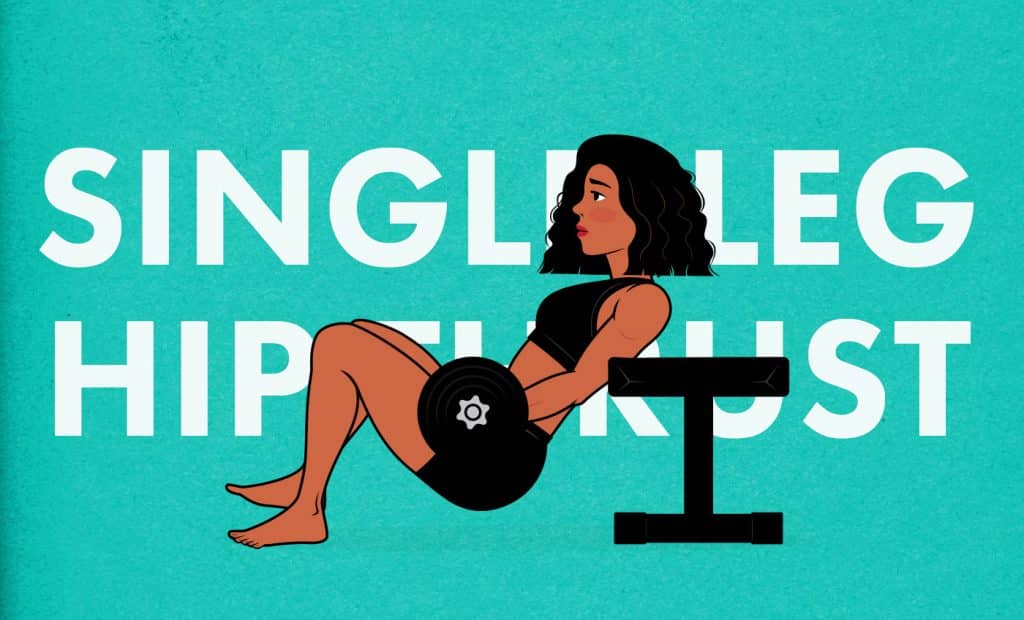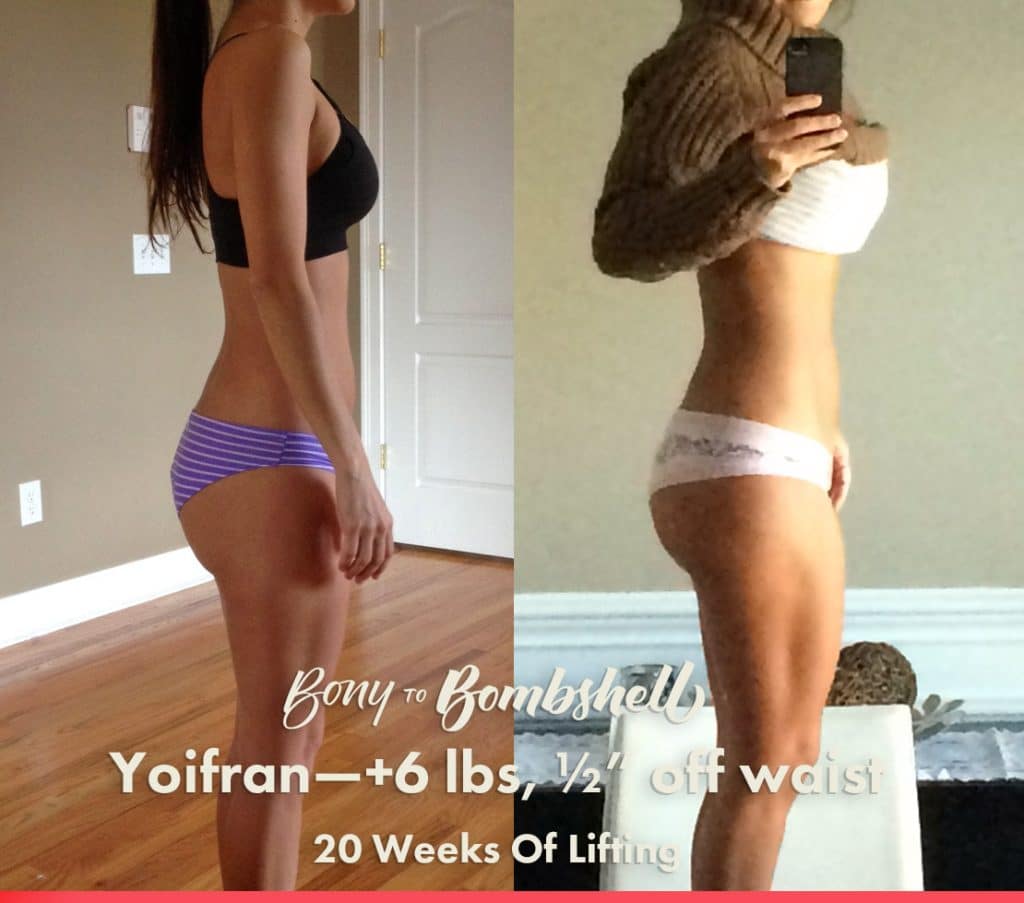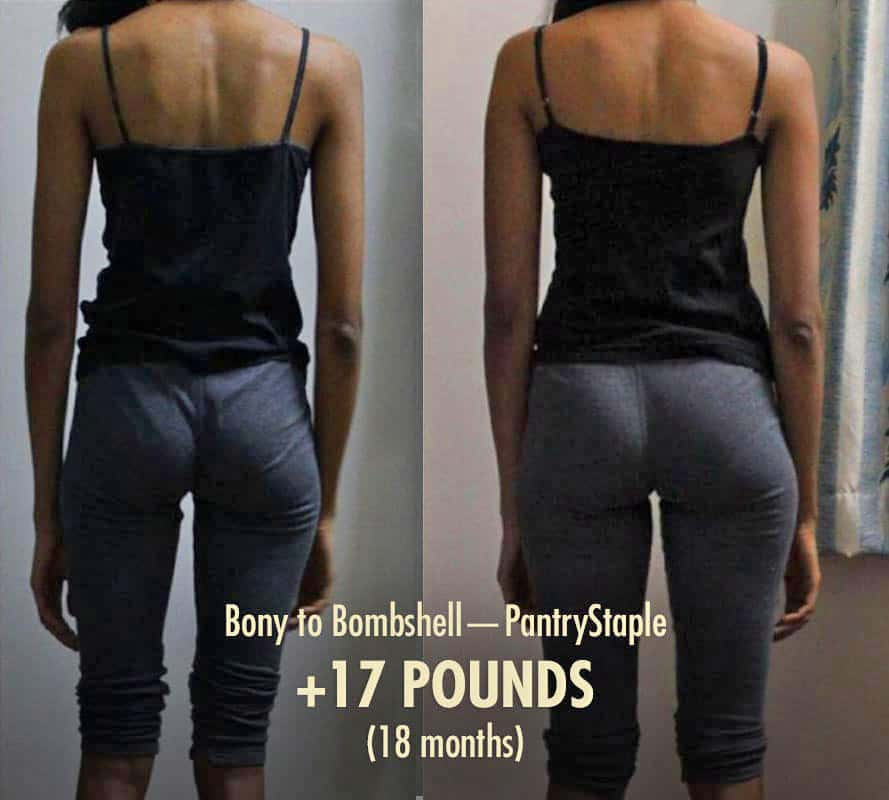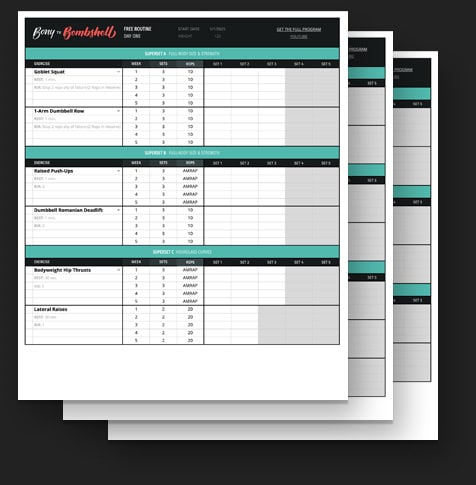
Single-Leg Hip Thrust: Overview, How-to, & Tips
The single-leg hip thrust is a great isolation exercise for building up the glutes. You can do it with your own body weight, or you can load it with a weight plate, a dumbbell, a kettlebell, etc. Inside we’ll show how to do the proper form (one version with your body weight and one with a weight), common mistakes to avoid, and tips for including it in your workout programming.
- Single-Leg Hip Thrust Overview:
- How to do The Single-Leg Hip Thrust Exercise: Video Demonstration
- Using The Single-Leg Hip Thrusts In A Workout
- Q&A About The Single-Leg Hip Thrust
- What Next?
Single-Leg Hip Thrust Overview:
The single-leg hip thrust is a variation of the more well-known hip thrust exercise. The hip thrust exercise is mainly used as a glute isolation exercise. It’s become a favourite for many female lifters because it is one of the most powerful exercises you can use for improving your butt size and strength, increasing your waist-to-hip ratio.

Benefits
- Improves glute strength and size. As a glute isolation exercise, this exercise effectively loads up the glutes. Because it is a single-leg variation, this makes the same weight heavier to the glute muscles, but without needing to use a heavier weight. This means that you don’t need access to a lot of heavy weights, and there will also be less weight sitting on your pelvis and supported by your core.
- Isolates the glutes from the quads (front of thighs). A lot of women depend on the squat movement as one of their main lower-body exercises. The squat is excellent for building up the lower body, but because it’s a knee-dominant exercise, it can make the quads (front of thighs) grow quite a lot compared to the glutes. With the hip thrust movement, you can isolate the glutes and take the quads out of the picture. This will allow you to add more size to the glutes (and, to a smaller degree, the hamstrings) to help with balance. If squats have made your legs so big that they make your butt look small in comparison, any hip thrust variation can be a great exercise to try.
- Teaches glute activation. Many women struggle with something called gluteal amnesia or “dead butt syndrome,” which means they have a hard time using their glutes properly. There are probably a lot of reasons for this (low-rise jeans?). A whole generation of us has somehow lost the ability to bend at the hips and instead bend with our backs. Sometimes when a woman starts squatting and deadlifting, they have trouble activating the glutes properly. Their quads and hamstrings like to jump in more than they should during the exercise. That means the legs blow up in size, and injuries might be more likely. The hip thrust movement can help someone learn what it feels like to work the gluteal muscles and help get those strong enough so that they can start assisting properly on heavier compound exercises like squats and Romanian deadlifts.
- It can help a woman look more feminine. Sexual dimorphism is the term used to describe the differences between males and females. Structural differences in the bodies are a huge part of those differences. Men have a common drive to have a thicker neck, wider shoulders, and stronger arms for protection and capacity for violence. For women, there is a common drive to have a lean and cinched-in waist with wide hips, which correlates with fertility health. Research has shown that women store omega-3 type fats (such as from fish) on their hips, which is necessary for building a baby’s brain, and both women and men pay attention to this, often without realizing it. Aside from glute fat, glute muscularity (and leg muscularity) is another sign of good general health. Using the single-leg hip thrust can help give some attention to the area and brings heightened blood flow for healing and recovery.
Muscles Worked
The single-leg hip thrust is an isolation exercise that mainly works the glutes, such as the:
- Gluteus Maximus. The gluteus maximus is the largest and strongest of the glute muscles, and it has the most potential to grow. Its main job is to thrust the hips forward, and that makes any hip thrust variation an excellent exercise to grow the gluteus maximus. Because the maximus is so large, for the best shape, it’s best to try and use a variety of exercises to hit both the upper and lower fibres of it. As you can probably guess, that means doing a variety of squats, deadlifts, and hip isolation exercises like the hip thrust.
- To a lesser extent, the hamstrings. One of the main differences between the glute bridge and the hip thrust is the range of motion. The glute bridge is a smaller range of motion, allowing you to isolate the glutes even more than a hip thrust. The hip thrust is a larger range of motion, allowing the hamstrings (back of thighs) to start firing. If your hamstrings need a bit of love while you’re improving your glutes, the hip thrust is a great lift.
- To a lesser extent, gluteus medius and minimus. These two glute muscles will get worked a bit with the hip thrust. But they mainly help to move your legs away from your body and to rotate them, so you will want to hit these other glute muscles with a compound leg exercise (like squats/deadlifts) and then some isolation work (like clamshells and side leg raises, etc.)
Required Equipment
- A weight. You can even use your own body weight to start off. But at some point, you’ll want a dumbbell, a kettlebell, or a weight plate to help keep you progressing as you get stronger.
- A place for your back to rest upon. If you are hitting the gym, you can use a standard bench and find a way to immobilize it so it doesn’t slide around. When hitting public gyms, we would place the bench right next to a wall so it couldn’t move. But if you’re lifting at home, you can just use the edge of your couch.
How to do The Single-Leg Hip Thrust Exercise: Video Demonstration
Here’s Bony To Bombshell coach Marco demonstrating how to do the single-leg hip thrust with just his body weight.
To keep progressing with this exercise, you can just put a dumbbell or weight on your lap. Here is Marco demonstrating the weighted version, with a slight variation in form, by using one arm to stabilize himself and one arm to hold the weight.
Proper Form Breakdown
- Set up a bench (or find your couch) and make sure it’s sturdy and motionless.
- Grab a weight that you can handle. It is better to err on the side of it being too light and redoing the set if you find it too easy.
- Get into the right position, with the back of your shoulders against the edge of the bench.
- Place the weight onto your lap.
- Thrust up into the top position, and raise one leg.
- Stabilize yourself with the same-side arm of the leg you’ve raised.
- Keeping your ribs in line with your pelvis, take a deep breath, dip down and start the movement.
- Once you reach the bottom position, push through your whole foot, breathing out as you do this.
- That is one rep. Do all the reps for one side.
- Then repeat on the other side. That is one total set.
Common Mistakes With The Single-Leg Hip Thrust
- Not matching the reps per side. When doing unilateral lifts like this, it’s normal for one side of your body to start off stronger. We’re not perfectly symmetrical. If you notice that you can do, say, 10 reps with your right leg, and only 9 with your left leg, continuing to do this will lead to a bigger imbalance. Always make sure that your reps match per side. Ideally, you would do your weaker side first, say 9 reps, and then match that with your stronger side, 9 reps—don’t keep going. Over time, your weaker side will catch up in strength, and you’ll have fixed some imbalances.
- Choosing too light of weight. Your glutes are strong. Surprisingly strong. Women often outgrow the bodyweight version of the single-leg hip thrust quickly. When the weight is too light, sometimes it allows your form to be a bit wonky since the weight doesn’t demand perfect form. Don’t be surprised that when you find the right weight, your form cleans up a bit.
- Disconnecting the ribs from the pelvis. The hip thrust is a more complicated exercise compared to the glute bridge. You need to make sure your ribs stay in line with your pelvis. Otherwise, you could hurt your lower back. Make sure your whole upper body starts in a straight, neutral line as your pelvis drops down.
- Not breathing! Too many women hold their breath and bang out tons of reps and wonder why they feel so lightheaded after this one. Take a breath in, lower, and breathe out as you contract your glutes, and breathe in as you lower the weight. At the very least, you should do a full breath between each rep.
Using The Single-Leg Hip Thrusts In A Workout
Use A Moderate Rep Range
In research, to optimize for muscle growth and muscle size, you want to choose a weight that you can do 4–40 repetitions with. The sweet spot for single-leg hip thrusts, though, is on the lower rep range of around 5-12 reps. Don’t forget you’ll need to repeat the reps on the other side!
If you find yourself not able to do 5 reps, use a lighter weight. If you can do more than 12 reps, use a heavier weight. That will guarantee that the workout is helping you gain both muscle size and muscle strength and not making endurance adaptations. Make sure you always match the reps on each side.
Challenge Yourself But Stop Short Of Failing
Ideally, you’ll stop your single-leg hip thrusts when you’re just about to fail, but you could still do a couple of reps more. But if you’re a beginner, it’s hard to know exactly how hard you’re pushing yourself. If you aren’t sure if you’re taking your sets close to failure, try doing more reps. Try pushing yourself all the way until you can no longer do any more thrusts with perfect form. That way, you’ll know what it feels like. You might be surprised that you were a lot stronger than you thought. Next time, stop right before that point of failure.
Start With Two Sets, Then Add More
Start with just a couple of sets, then over time, add more sets as you get stronger. We recommend doing two sets in the first week. Practice your form, find the right weights, and take your time learning the hip thrust movement.
Next week, if your glutes, hip bones, and low back aren’t too sore at the start of each workout, try adding a set to each exercise. If that goes well and you feel ready for more, add another set next week. You can do around 3–6 sets per exercise. Most women will do best with 3–4 sets. If you ever start to feel worn down, or if you’re coming back after a long break, start the cycle over again, going back to just two sets and rebuilding from there.
Rest 1-2 Minute Between Sets
How long you rest between sets of the single-leg hip thrusts isn’t that important. Whether you rest for 2 minutes or 10 minutes, you’ll still stimulate a similar amount of muscle growth. The important thing is that you rest long enough to catch your breath, ensuring that your cardiovascular system doesn’t limit the performance of your muscles. We want to challenge your glute muscles, not just your heart (though your heart will get a good workout, too!).
The main reason to rest for just a couple of minutes is to keep your workouts shorter. You don’t want to spend all day in the gym. But if you need more rest or get interrupted partway through your workout, no problem. Just pick up where you left off.
If you want to blast through your workout even faster, you can do the lifts in a circuit/superset. Do a set of single-leg hip thrusts, rest a minute, then do a set of raised push-ups, rest a minute, then do your second set of single-leg hip thrusts, and then do your second set of raised push-ups. That way, you’re still giving different muscle groups plenty of time to recover between sets, but you’re doing another exercise during the rest period.

Free Routine For Female Beginners: Glute Emphasis With Full Body Workout: Includes The Single-Leg Hip Thrust
If you don’t have a workout, you might be interested in our full Bony to Bombshell program. A sample beginner’s workout for women that includes glute bridges could look like this:
- Weighted Single-Leg Hip Thrusts: 2 sets of 6 reps per side.
- Raised Push-Ups: 2 sets of as many reps as you can.
- 1-Arm Dumbbell Row: 2 sets of 10 repetitions.
- Dumbbell Goblet Squats: 2 sets of 10 repetitions.
- Lateral Raises: 2 sets of 10 repetitions.
- Bonus Glute Work: 2 sets of Dumbbell Romanian deadlifts, clamshells, glute bridges, donkey kicks, etc.
GET THE free GOOGLE SPREADSHEET OF THE
female BEGINNER’S FULL-BODY with glute targeting WORKOUT

Get the glute targeting workout as a Google spreadsheet. You’ll be able to pick from exercise alternatives, and fill out the sheet.
Plus, we’ll make sure you’re on the Bony to Bombshell newsletter, and send you all of our best women's muscle-building content.
Q&A About The Single-Leg Hip Thrust
Q: What are the differences between the single-leg variation and the regular hip thrust?
The regular hip thrust is more stable because you have two points of contact into the ground. This allows you to push more weight. For this reason, you ought to have two feet on the ground for the barbell version of the hip thrust. The regular hip thrust also takes slightly less time because you don’t need to repeat the reps again on the other leg.
The single-leg variation instantly makes the same weight mechanically heavier on the glutes. This means a few things:
- If you’ve run out of weights at home, you can keep progressing with the same weight.
- If you find the heavier weights painful on your pelvis or lower back, you can make it harder for your glutes with less total weight.
- Each variation subtly changes the mechanics of the lift. When your body is imbalanced, it will challenge your stabilizer muscles more. This might help with athleticism or hit different fibres in the glutes. Variety is key to keeping things fresh in the gym.
Q: Is the single-leg variation good for working the glutes?
The single-leg version is great for working the glutes. It’s a great way to keep things progressing and add variety to your workout plan.
Q: What are some alternatives to the single-leg hip thrust?
Obviously, doing the regular hip thurst exercise is the most common alternative. But there are other glute isolation exercises, like the glute bridge, that are similar. The Romanian deadlift is a compound exercise that includes other muscles (like the forearms, the core, and more of the hamstrings, but still has that same hip motion that is great for the glutes.
Single-Leg Hip Thrust Alternatives & Variety
Barbell Hip Thrust
Glute Bridge
Bulgarian Split Squat
What Next?
If you liked this article, you’d love our muscle-building newsletter. We’ll keep you up to date on all the latest muscle-building information for women. Or, if you want us to walk you through the process of gaining muscle and strength, including teaching you the exercises, giving you a structured 5-month workout program, a complete diet guide, a recipe book, and online coaching/customization, check out our Bony to Bombshell Program.



FREE women's Muscle Growth MINI-COURSE
Get our 5-part female bulking mini-course that covers everything you need to know about:
Here are some related articles